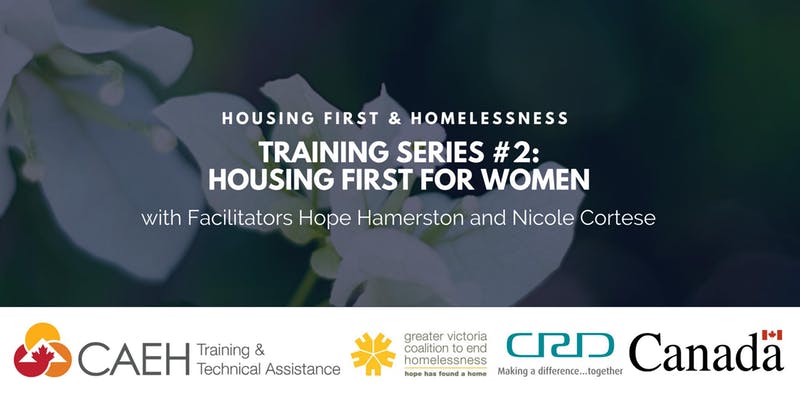NOTE: Our thanks to Hilary Marks for her report on this workshop, and for all of her work to end homelessness in Greater Victoria.
If you are interested in attending a Canadian Alliance to End Homelessness community training session, see details on the upcoming topics and dates on our website.
Housing First for Women and their children: A participant’s report
I attended a workshop put on by the Canadian Alliance to End Homelessness and the Coalition to End Homelessness, in partnership with the CRD and funded by the Government of Canada. Most of the people in the room were known to each other, by either working together, or sharing resources and being front line workers.
The territory acknowledgement from what I could hear was beautiful. “Smiles are free” and “don’t be afraid.” She sang and said a beautiful prayer for everyone.
The question was poised, “what do you want out of the training?”
I want an “AHA moment.”
The presenters Nicole Cortese and Hope Hamerston, both of whom I met at the CAEH 2018 conference in Hamilton, start the discussion around Housing First. What kinds of things are involved with Housing First and what does it mean? They talk about all the ways women experience homelessness and how they survive. They spoke about the analogy of “the woman is the driver” and we [people working in the homelessness sector] are the navigators. The women are the experts on their needs. Housing was definitely the basic human right but that still does not mean that everyone has one. We assist the women on their journey when they gain Housing First. Nicole and Hope spoke about programs and Housing First core principles. There was some discussion about what things do not facilitate a choice, like paying the rent every month. They described the relationship of the third party to help the relationship of Landlord/tenant and tenant/support worker. To help facilitate some ground work and rules that creates boundaries and healthy goals.
There is an intersectionality that must happen with all ministries that are involved in solving homelessness and poverty for women and children.
The safety of women and children is paramount and trauma finally makes its way into the conversation. VAW (Violence against Women) was in the conversation.
The space of the workshop was beautiful, the food was good, but the sound system was not geared for some of us with hearing impairments. A lot of the information was repetitive. It was a little dry and lacked new and exciting ways that we could address women’s and children’s issues of homelessness. Lots more trauma informed peer support ideas would be beneficial.
One good idea that came up was having municipalities take on an issue. (Seeing as we have 13 municipalities), seniors, youth, veterans. (Loved the look on Nicole and Hope’s face when we told them we had 13 municipalities. With that many city councilors, mayors, and city office workers, we could do a lot! That is a lot of money!)
We spoke of the role of pets in peoples’ lives, and how beneficial it is and how those same pets can be barriers to housing.
The information was full and accurate. I enjoyed connecting with Nicole and Hope and I am grateful that I got to experience the workshop, but I never got the AHA moment.
Thank you,
Hilary Marks
